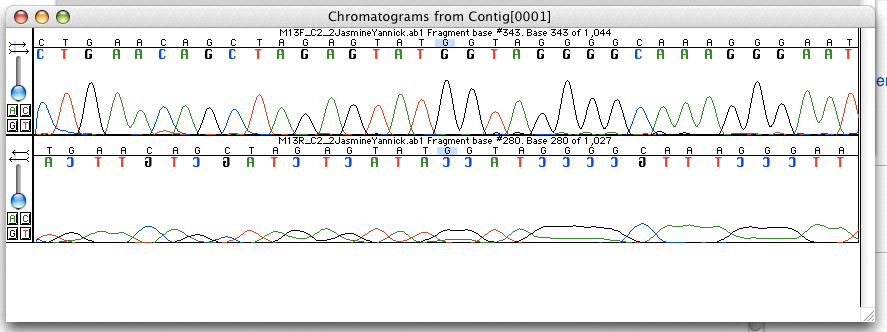Electropherogram on:
[Wikipedia]
[Google]
[Amazon]


 An electropherogram (also called electrophoretogram, sequencing chromatogram, EPG, and e-gram) is a record or chart produced when
An electropherogram (also called electrophoretogram, sequencing chromatogram, EPG, and e-gram) is a record or chart produced when
PHPH
— web-based tool for electropherogram quality analysis
* ttp://dna.reinyday.com/464/ DYS464 Electropherogram Interpretation Discrepancywith images Applied genetics Biometrics DNA Genetic genealogy Genetics techniques Laboratory techniques {{Genetics-stub


 An electropherogram (also called electrophoretogram, sequencing chromatogram, EPG, and e-gram) is a record or chart produced when
An electropherogram (also called electrophoretogram, sequencing chromatogram, EPG, and e-gram) is a record or chart produced when electrophoresis
Electrophoresis is the motion of charged dispersed particles or dissolved charged molecules relative to a fluid under the influence of a spatially uniform electric field. As a rule, these are zwitterions with a positive or negative net ch ...
is used in an analytical technique, primarily in the fields of forensic biology, molecular biology
Molecular biology is a branch of biology that seeks to understand the molecule, molecular basis of biological activity in and between Cell (biology), cells, including biomolecule, biomolecular synthesis, modification, mechanisms, and interactio ...
, and biochemistry
Biochemistry, or biological chemistry, is the study of chemical processes within and relating to living organisms. A sub-discipline of both chemistry and biology, biochemistry may be divided into three fields: structural biology, enzymology, a ...
. The method plots data points that represent a specific time and fluorescence
Fluorescence is one of two kinds of photoluminescence, the emission of light by a substance that has absorbed light or other electromagnetic radiation. When exposed to ultraviolet radiation, many substances will glow (fluoresce) with colore ...
intensity at various wavelengths of light to represent a DNA profile..
In the field of genetics, an electropherogram is a plot of DNA fragment sizes, typically used for genotyping Genotyping is the process of determining differences in the genetic make-up (genotype) of an individual by examining the individual's DNA sequence using bioassay, biological assays and comparing it to another individual's sequence or a reference seq ...
such as DNA sequencing
DNA sequencing is the process of determining the nucleic acid sequence – the order of nucleotides in DNA. It includes any method or technology that is used to determine the order of the four bases: adenine, thymine, cytosine, and guanine. The ...
. The data is plotted with time, shown via base pairs (bps), on the x-axis and fluorescence intensity on the y-axis. Such plots are often achieved using an instrument such as an automated DNA sequencer paired with capillary electrophoresis (CE). Such electropherograms may be used to determine DNA sequence genotypes, or genotypes that are based on the length of specific DNA fragments or number of short tandem repeats (STR) at a specific locus by comparing the sample to internal size standards and allelic ladder data using the same size standard. These genotypes can be used for:
*genealogical DNA test
A genealogical DNA test is a DNA-based Genetic testing, genetic test used in genetic genealogy that looks at specific locations of a person's genome in order to find or verify ancestral genealogical relationships, or (with lower reliability) to ...
ing
*DNA paternity testing
DNA paternity testing uses DNA profiling, DNA profiles to determine whether an individual is the biology, biological parent of another individual. Paternity testing can be essential when the rights and duties of the father are in issue, and a ch ...
*DNA profiling
DNA profiling (also called DNA fingerprinting and genetic fingerprinting) is the process of determining an individual's deoxyribonucleic acid (DNA) characteristics. DNA analysis intended to identify a species, rather than an individual, is cal ...
*phylogenetics
In biology, phylogenetics () is the study of the evolutionary history of life using observable characteristics of organisms (or genes), which is known as phylogenetic inference. It infers the relationship among organisms based on empirical dat ...
*population genetics
Population genetics is a subfield of genetics that deals with genetic differences within and among populations, and is a part of evolutionary biology. Studies in this branch of biology examine such phenomena as Adaptation (biology), adaptation, s ...
See also
* Gel electrophoresis of nucleic acids *Chromatography
In chemical analysis, chromatography is a laboratory technique for the Separation process, separation of a mixture into its components. The mixture is dissolved in a fluid solvent (gas or liquid) called the ''mobile phase'', which carries it ...
References
External links
PHPH
— web-based tool for electropherogram quality analysis
* ttp://dna.reinyday.com/464/ DYS464 Electropherogram Interpretation Discrepancywith images Applied genetics Biometrics DNA Genetic genealogy Genetics techniques Laboratory techniques {{Genetics-stub